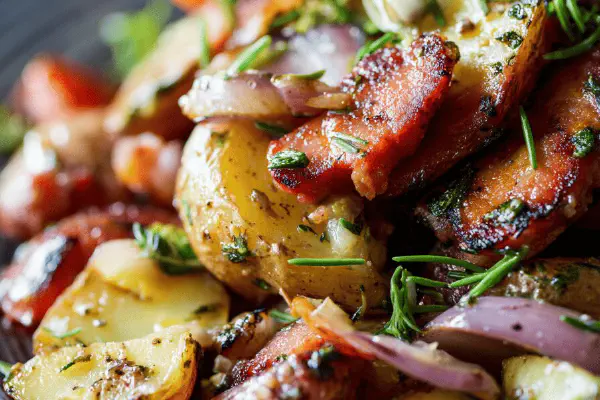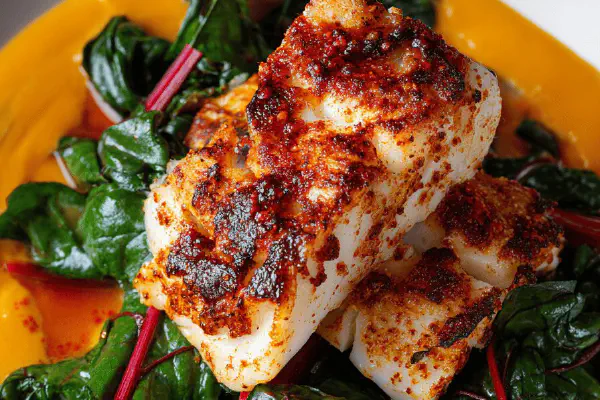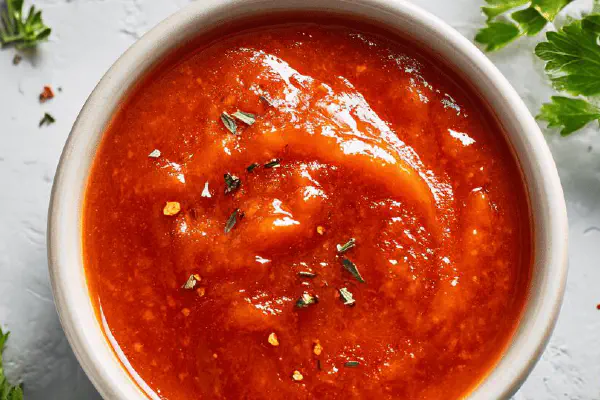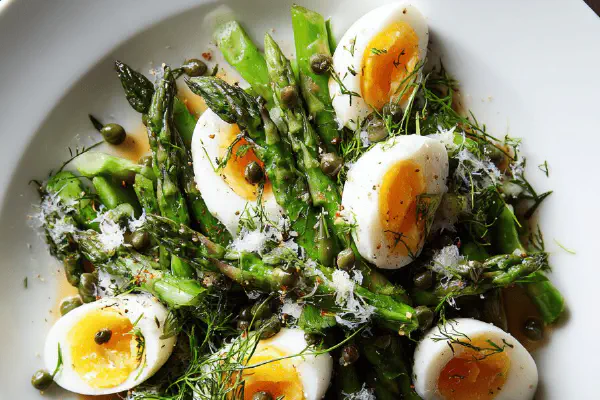Rustic Potato Bacon Salad

By Emma
Certified Culinary Professional
Ingredients
- 900 g (2 lb) fingerling potatoes
- 5 slices pancetta, diced
- 25 ml (1 1/2 tbsp) avocado oil
- 2 shallots, finely chopped
- 25 ml (1 1/2 tbsp) apple cider vinegar
- 15 ml (1 tbsp) grainy Dijon mustard
- 60 ml (1/4 cup) fresh tarragon, chopped
About the ingredients
Method
Timing and Potatoes
- Start cold water with potatoes. Salt it moderately; brings out slow absorption. Heat up until steady boil. Don’t rush—gently boil about 25 minutes. Test with fork; slips in easily but still structured. Drain and let cool just enough to handle, halving size for even cooking and better sauce absorption.
Rendering Pancetta and Aromatics
- Use a wide non-stick skillet. Pancetta first, medium heat-ish. Listen—the gentle crackle should turn loud then soft, fat renders out, edges crisp. About 7 minutes. Watch for no burning (bitter). Add shallots—soften and tint golden, not brown. Aromatic sweetness emerges here, about 6 minutes. Patience breeds flavor depth.
Marrying Components
- In the same pan, potatoes go back in. Stir for 4 minutes, all sides kissed by fat and caramelized bits. You want to see surfaces blush golden, texture firm but not stiff. Pour vinegar in—a quick sizzle, pan deglazes, sticky browned bits lift up. Off-heat, whisk in mustard till smooth. Toss in chopped tarragon. Season with salt sparingly; pancetta brings saltiness. Pepper freshly ground is a must.
Serving and Variations
- Serve warm or room temp. Cold subdues flavors but still good. Pancetta can switch to smoked turkey bacon or diced chorizo for warmth and spice twist. Avocado oil swapped with walnut oil if you want an earthier, nuttier note. Tarragon swapped with fresh dill if you’re after brightness.
Troubleshooting
- Potatoes mushy? Reduce boiling time, use waxy types like fingerlings or Yukon gold. Pancetta too chewy? Cook longer on lower heat to render fat fully. Vinegar too sharp? Use less, or balance with a pinch of maple syrup or honey.
Tips
- Cut potatoes while warm to keep shape but allow seasoning to penetrate. Use cast iron skillet if non-stick unavailable, but adjust heat carefully to prevent sticking. Let the pan dictate cooking rhythm.
Leftovers
- Reheat gently, add fresh herbs just before serving for punch. Texture loses some crispness over time but flavor deepens.
Cooking tips
Chef's notes
- 💡 Start potatoes cold in salted water. Slow absorption helps inside cook firm but tender. Boil gently; rushing breaks skins and mushes texture. Fork test key. Not fork-through soft but with bite. Then drain; cool enough to halve without crumbling. Halving aids even cooking and holds sauce better later. Avoid russets here unless chunkier mash is okay.
- 💡 Use medium heat when rendering pancetta. Listen closely: first loud crackle turns soft pop, fat is rendering out, edges crisp. About 7 minutes. Burnt pancetta tastes bitter—no good. Add shallots only once fat's right, cook low to soften and caramelize till golden but not brown. Takes patience. This layering builds savory-sweet contrast and keeps sharp acid balance later.
- 💡 Potatoes return to same pan after blistering pancetta; stir to coat in fat and caramelized bits 4 minutes. Surfaces should blush golden, not pale or blackened. When vinegar hits hot pan, immediate sizzle deglazes sticky browned bits giving acid brightness. Off heat whisk in grainy Dijon mustard; sauce smooths and clings. Toss fresh chopped tarragon last off heat to keep brightness alive. Salt light; pancetta salty enough. Fresh cracked pepper mandatory to balance flavors.
- 💡 If pancetta missing, diced smoked turkey bacon or thick ham work, different smoking intensity but same fat render idea. Avocado oil high heat stable; swap for olive oil careful with temp or walnut oil for nuttier tone. Dill or flat-leaf parsley swap for tarragon if licorice notes not your thing. Shallots provide softness and mild sweetness; onions only if thin sliced and slow cooked to avoid harshness.
- 💡 Cut potatoes warm, not hot or cold. Warmer flesh holds shape best but still accepts seasoning deeply. Cast iron skillet ideal if non-stick absent; adjust heat down to avoid sticking. Pan temp dictates rhythm—too hot scorches edges bitter, too cool no caramel. Reheat leftovers gently, add fresh herbs last minute to revive punchiness. Texture will soften but flavor concentrates with time.
Common questions
Potatoes mushy how to fix?
Cut boiling by 3 to 5 minutes. Use waxy types like fingerlings or Yukon gold, they hold more firm. Russets risk crumble. Test with fork for tender but firm. Also cool potatoes before halving; rushing breaks texture.
Pancetta chewy?
Render fat longer at lower heat. High hits quick burn, tough bits. Patience here turns crisp and tender. Alternatives: smoked turkey bacon or thick ham, less fat but similar structure. Thickness also matters; thin dice renders quicker.
Vinegar too sharp what now?
Cut amount, add pinch maple syrup or honey for balance. Or swap cider vinegar for white wine vinegar less biting. Balsamic white sweeter, use cautiously if at all. Acid sharpness impacts overall balance.
How store leftovers?
Refrigerate loosely covered, best next day. Reheat slow on pan or microwave low power. Add fresh herbs off heat, preserve brightness. Freeze not recommended; texture breaks down and pancetta fat alters. Room temp service possible but avoid chilling cold, flavors mute.



